Best Solar Generator Reviews (2024) – Top 6 Power Stations
In this article, we are reviewing the best solar generator based on power input/output, battery capacity, size, and weight, reliability, outlets, budget, and charging options.
The solar generator market is growing exponentially by the day. Every outdoorsman wants a cleaner, reliable, renewable, noiseless, compact, lightweight, and efficient power source for camping, Overlanding, and RVs.
With the growing cost of gasoline, solar power stations are slowly making their way into the homes as backup power sources as well.
I have seen hundreds of people in my society relying on solar generators for power outages instead of portable inverter generators because they charge and use their units directly from the solar panels instead of spending on fuel.
We have written this comprehensive guide to give you a choice between the top 6 best power stations if you are going to purchase one in the future.
Top Picks
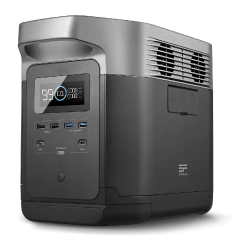
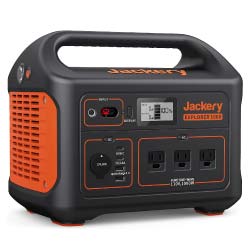
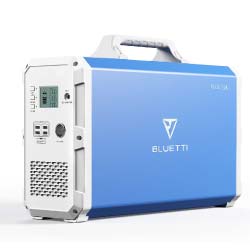
How We Selected The Best Solar Generator?
All of the members of our team are outdoor enthusiasts. We receive plenty of opportunities to test and review outdoor gear including inverter generators, solar panels, solar generators, batteries, and other related items.
We tested 17 power stations, talked to 13 outdoorsmen, interviewed 15 people who are currently working in different manufacturing companies and gathered online data to select only 6 best solar power stations.
These selected solar generators are used for backup emergency power, camping, Overlanding, RVs, and driving around.
How Do Solar Generators Work?
Solar panels convert sunlight into DC (direct current) electricity. That electricity is stored in the battery. The battery’s job is to distribute the whole energy onto the appliances.
There is a charge controller that prevents overcharging and overheating problems. Before the battery distributes the power, an inverter converts the DC power into accessible AC power. The inverter bypasses the electricity to the devices.
Why should I Buy a Solar Generator?
A solar generator allows you to go completely off-grid and rely less on gas. You can use your solar panels to charge your battery if they run out. Solar generators are easy to use, lightweight, and manageable. They are highly reliable when you need power in emergencies.
For people who drive a lot and like to charge their appliances while driving, a solar power station is a lifesaver.
A 12V DC car plug will power your fridge and charge your appliances while you drive.
1. Jackery Explorer 1000 – Portable Power Station
FEATURES & SPECS

Jackery Explorer 1000 is one of if not the best solar generators in the current market.
It is super-duper portable and lightweight, it features a 1002Wh lithium-ion battery of the highest quality, and 3 pure sine wave AC outlets to power sensitive AC appliances. You can connect two solar panels to this power station.
Jackery 1000 can provide 1000 watts of continuous power and 2000 watts of surge power. It means when you plug in motor-driven devices, the generator will surge above 1000 and come down again, and the generator doesn’t trip.
Motor-driven devices needed a few extra watts for a short time to overcome inertia.
Input and output power along with the percentage of battery left is displayed on the illuminated screen. It has the following ports.
- 3 pure sine wave ports
- You got a DC power input
- Anderson power pile input,
- Two USB A ports,
- Two USB Cs,
- Output for DC.
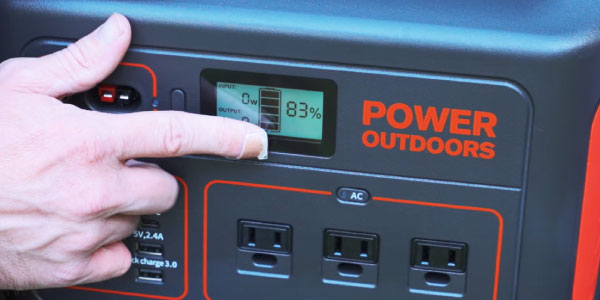
There is a decent flashlight on the back which is pretty handy for campers like me. There are three ways to charge Jackery Explorer 1000. The wall, solar, and DC.
So I saw someone plug Jackery 1000 into the DC port of the Dometic 28 refrigerator, and jackery into the truck. The guy had continuous power for his fridge for days and days.
I tried the same setup in the summer without recharging my jackery. It ran my Dometic 28 for 4 days and hours. The fridge was set at 1C.
The built quality and reliability are top-notch. Probably the most durable power station out there. I have done a couple of Overlanding trips with this little bad boy and I don’t see any issues to point out.
The customer service is really good and reliable. They offer email, phone number, and address to give you support anytime.
Real charging time
- Roughly 7 hours from the wall.
- 8 hours from two solar panels 100 watts each.
- 15 to 16 hours from 1 solar panel of 100 watts.
- 14 hours from vehicle DC power.
What Appliances Jackery explorer 1000 will charge?
- Laptop = 9 charges
- Cellphone = 100 charges
- Coffee maker = 50 mins
- TV = 13 hours
- Microwave = 45 mins
- Mini Cooler = 17 hours
I have run many appliances and tools with this without any problem.
Not all power stations can reach 1000W capacity, but Jackery Explorer 1000 gave almost 1090W maximum during the load test I conducted. It ran everything I gave it without changing the noise patterns.
Speaking of noise, it is virtually noiseless so didn’t conduct any noise test.
So overall Jackery Explorer 1000 is a highly compact and lightweight solar generator with an amazing 3-way charging type and amazing built-in quality.
The only problem I see is a bit pricy.
2. Bluetti AC200P 2000W Portable Solar Generator
FEATURES & SPECS
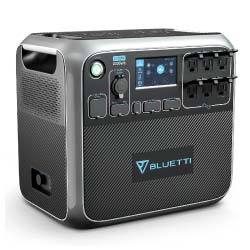
Bluetti AC200P solar generator is for long trips to provide sufficient clean power for your daily life appliances. It is portable and ideal for campers.
It can provide a continuous power of 2000 watts, and 4800 watts surge which is huge if you have a lot of motor-driven appliances. The generator won’t trip.
It has 17 different outlets with dust caps. You can practically plug in anything within the 2000 watts power range.
You can charge your Bluetti AC200Pusing solar panels, a wall outlet, or a car DC plug. It gives great flexibility for charging during cloudy days.
Bluetti AC200Pcomes with very nice cables to charge this unit. For the output, you even have an Anderson power pole to connect DC output for the 25 amps.
You can plug your solar panels right into it because it has a built-in charge controller.
Charging time:
- Solar panel: 700W Max: 3.5 to 3.6 hours
- AC generator: 4.5 to 5.6 hours
- Solar + wall: 1200W Max. 2.2 to 2.6 hours
- Dual AC: 2 AC adapters: 2.5 to 3.1 hours
The touchscreen displays a lot of features and details regarding AC input and output, DC input and output, real-time display of voltage, current, temperature, state of the batteries, etc.
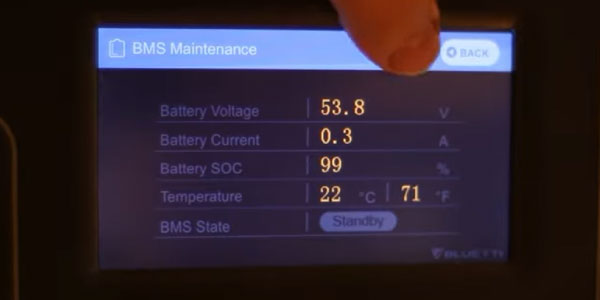
There is an eco-mode as well. If there are small loads attached to the inverter, it will shut it down to save battery power.
This unit has over current, short current, over-voltage, overcharge, over-discharge, and thermal protection, and it is super silent at work.
I did a little load test, I managed to scrap 1980W. The meter is for the output. The fact that it passed the test is a huge deal for me.
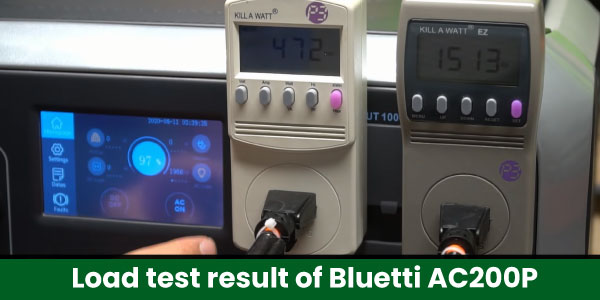
What appliances Bluetti AC200P will charge?
- Cellphone = 170 to 180 charges
- Laptop = 25 to 30 charges
- Mini fridge = 25 to 28 hours
- TV = 15 to 20 hours
- 100W projector = 15 to 20 hours
- 8000BTU AC = 5 to 7 hours
- Coffee maker = 5 to 70 hours
- Hair dryer = 70 to 75 minutes
The main reason I bought this Bluetti AC200P solar power station was to be able to charge while I was driving. It is one of its main benefits.
The only problem I have with this unit is the BMS. Bluetti AC200P has a very inefficient BMS.
If you leave this thing overnight while charging camera batteries, cellphones, and other small things, it will discharge around 25% of the capacity. BMS eats up a lot of power.
A lot of people ignore this problem because of the features and reliability Bluetti AC200P provides.
I have also written a complete review of Bluetti AC200P.
3. Goal Zero Yeti 1000 Core Portable Solar Generator
FEATURES & SPECS
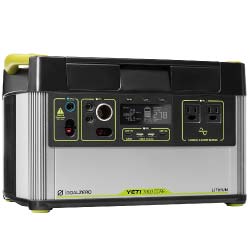
Goal Zero Yeti 1000 is one of the most popular and reliable outdoor solar power generators money can buy. I have used this model for 4 months to gather enough data for the review.
Let’s talk about the design first. The flat top and compact dimensions are made for campers and transportation. It has a low center of gravity so you can bring it in the back of a pickup truck without strapping it down.
Lithium battery solar power stations of the same capacity weigh a lot more. Yeti 1000 is a portable power station which is a huge bonus for travelers and people who lug their power stations around a lot.
Goal Zero Yeti 1000 looks identical to Yeti 1000X but there are some differences. Instead of 1500 watts, it comes with a 1200-watt inverter with the same efficiency and capability.
Appliances Goal Zero Yeti 1000 Core will charge?
- Fridge: 15 to 18 hours
- Laptop: 17 to 20 hours
- Camera: 50 to 55 hours
- Drone: 15 to 17 hours
- Electric grill: 14 to 16 hours
- Drill: 12 to 14 hours
It can power multiple small appliances at the same time and its BMS doesn’t discharge quickly if you leave it all night. BMS doesn’t eat much charge which is a relief.
I was able to get 1192 watts maximum during my load test. I was super impressed with its power output.
Cigarette style port, fast charging port, and other outlets are the same as the YETI 1000x including the LCD. That LCD shows a ton of important information.
Goal Zero Yeti 1000 has a 6mm barrel plug so can use goa zero lights or anything that requires 12V using male 6mm plugs.
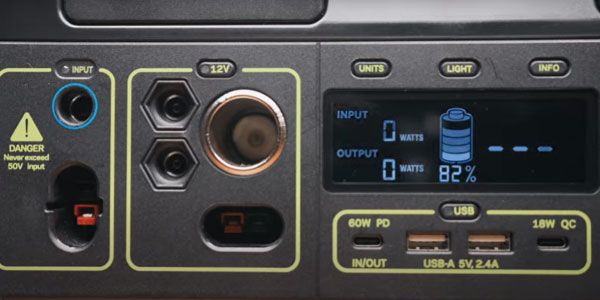
It has a 3-way charging type (solar, wall, car) and a high-quality MPPT charge controller which is very efficient.
It has 300-watt max on solar. To get 600 watts max on solar, you need 800 watts of solar panels.
The idea behind 300 watt limit of the charge controller is to take advantage of the unit without spending thousands of dollars on 800-watt solar panels. 300 watts is affordable.
The maximum advantage of solar panels can be taken by utilizing optimum solar panel orientation according to this research.
Charging time of Goal Zero Yeti 1000
- Wall outlet: 9 to 9.3 hours
- 230W power supply: 5 to 5.2 hours
- 12V DC car plug: 9 to 9.4 hours
- 300W solar panels: 4 to 4.3 hours (depending on the weather)
Batteries don’t charge in a linear path, in the start and finish, they charge a bit slower, but from 20% to 80%, they charge faster. So the charging numbers are rough estimations.
There was a WIFI Bluetooth controller on the X series that allows using an app on the phone to control the DC ports and inverter, and to read the screen info without WIFI signals. Goal Zero Yeti 1000 core doesn’t have this feature to cut down the cost and heat.
Overall, Goal Zero Yeti 1000 core is a budget-friendly variant made for travelers, campers, and outdoor enthusiasts. It is lightweight and portable, it charges pretty fast and holds the charge pretty well.
4. EF EcoFlow Delta 1300 Portable Power Station
FEATURES & SPECS

EF EcoFlow Delta 1300 is a 1260Wh lithium battery solar power station with 1800W pure sine wave continuous power to keep the lights, small refrigerator, microwave, coffee maker, AC, laptops, lights, and other small appliances running for hours.
It has both AC and DC ports. All the AC ports on the back side with cigarette-style outlets.
Appliances EF EcoFlow Delta 1300 will run according to our test
- 60w Laptop: 23 hours. 32 charges
- Power saver light: 37 hours
- 600w Coffee maker: 55 cups
- 120W Freezer: 10 to 17 hours
- 1600 Hair dryer: 1 to 3 hours
- 110W TV: 7 to 8 hours
- 500W blender: 2 to 2.5 hours
- 65W projector: 11 to 13 hours
The thing that set EF EcoFlow Delta 1300 apart is the overall power output of 1800W and the overall capacity of 1260Wh. If you were to power a 50-watt fan, it will run for approximately 24 hours which is crazy.
The X-Stream technology feature in this little beast can recharge the power station in no time.
Fast charging
I did some charging tests. The product description on Amazon says this unit can go from 0 to 80% in 1 hour, and 0 to 100% in 2 hours. I found it can go from 0 to 80% in less than an hour, and 0 to 100% in 1 hour and 40 minutes.
This is insanely fast for a solar generator. I can see why it crushing the competition. I used a wall outlet for the charging.
It can be equipped with any solar panel with an MC4 port only, 400W only. MC4 to XT60 connector is included.
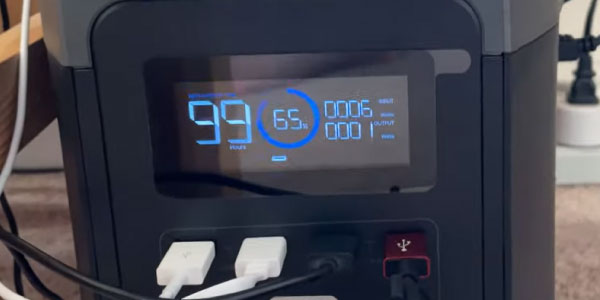
Charging Options
- AC outlet: 1 hour and 40 minutes
- Solar: 3.5 to 7.1 hours
- 12V car charger: 14 hours
The display tells the time left.
I will talk about its display for a second. The unique thing about the display interface is it tells you how many minutes or hours you have left on the power station.
I tested it on my cooler. The device said you had 2 hours left, and it ran for 2 hours and 2 minutes which is about 99% accurate.
You can charge the battery at the same time you are using it which is why it shows input and output signals on the display.
People often use it as an emergency backup system after fully charging it because it doesn’t drop the charge easily. The BMS is on it very efficient. The device holds the charge pretty well.
Because of how small and portable EcoFlow Delta 1300 is, it is used as a camping power station as well. You can bring it and have enough power to charge your laptops and cellphones, run the microwave, coffee machine, etc.
Who would recommend it for?
People who need a large amount of power in a portable body. For campers, as an emergency backup power, and for RVs.
5. MAXOAK Bluetti EB150 Portable Solar Generator
FEATURES & SPECS
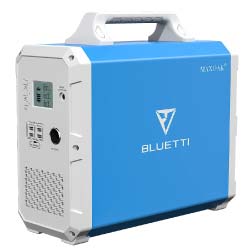
After using MAXOAK Bluetti EB150 for a couple of months on a road trip and camping, I have gathered enough data to write an accurate review.
This is a very high-power capacity power station with a whopping 1500Wh capacity. The description says it can deliver 1000 watts but I have tested that and managed to go beyond this output.
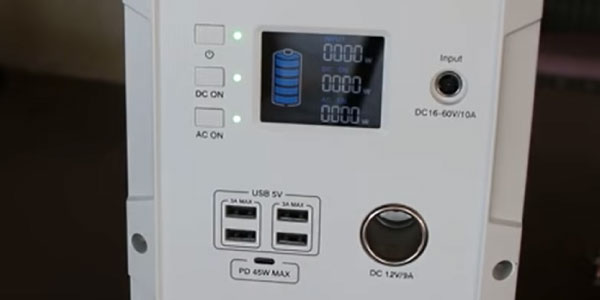
It is a pure sine wave generator with more than 90% efficiency. There are USB A ports, USB C ports, a regular 12V DC car outlet, and a high current USB A socket on this power station.
You can charge this device with up to 500W of solar panels. It takes about 3 to 4 hours to fully charge from fully empty with solar. I tested that theory on a bright, clear, sunny day.
From the wall socket, you are looking at about 9.5 to 10 hours. It charges faster using solar which is pretty damn good
MAXOAK Bluetti EB150 has one of the better MPPT charge controllers built-in.
Time for some solar charging test
I test the solar charging but unfortunately, some clouds were hiding the sun and I was only able to get 327 watts. So it took about 4.4 hours to charge which is not bad at all.
On MPPT and my watt meter was showing the same wattage rating. The working voltage was also great. It is a truly efficient, working MPPT controller.
What appliance MAXOAK Bluetti EB150 will charge?
- Laptop = 9 charges
- Cellphone = 90 charges
- Coffee maker = 40 mins
- TV = 13 hours
- Microwave = 40 mins
- Mini Cooler = 15 hours
Testing the inverter
- I put the max: a load of 1000 watts on the inverter and it lasted for 3 minutes (1050 to 1100 input/1005 output. 91 to 95% inverter efficiency).
- At 900 watts, it lasted for about 1 hour and 15 minutes.
After calculating the power input, output, and losses, the final efficiency of the inverter was 95.1% which is pretty good. If you want to learn about solar inverters in general, read our article about solar inverters and their types.
It is not as good as Goal Zero Yeti’s output. Goal Zero has a better discharge rate.
Compared to the competition, MAXOAK Bluetti EB150 has the same input capability, has double the output, and is 400 dollars cheaper than Inergy Apex with better solar input. It is practically crushing the competition.
Solar input
The 60V solar input is far better than the competition, but it should’ve been 100 to 150. People could string all the panels in the series if it were close to 200V, but 60V input is also fine considering the price tag.
6. Jackery Explorer 500 Portable Power Station
FEATURES & SPECS
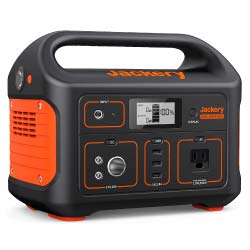
Jackery Explorer 500 is a lightweight, compact, portable, and affordable solar power station that lets you power your essentials on every travel.
I am reviewing this product after using it for camping and Overlanding for 9 months.
I typically use it to charge my cellphone, navigation device, batteries of my drones, and other small appliances, I normally charge them while I drive, but sometimes I use solar panels as well when I am stationary.
I carry a small fridge with me while I drive and camp and this thing constantly run my fridge.
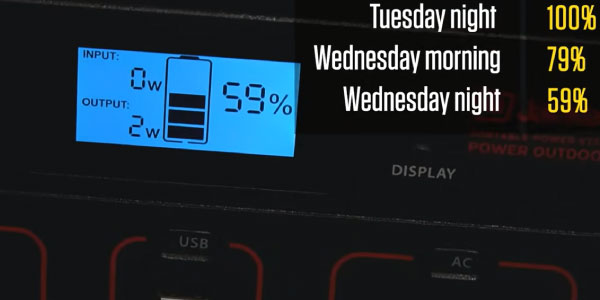
During one of my many tests, Jackery Explorer 500 was able to run my small fridge for two and half days without getting recharged.
Even if I power my fridge for 15 or 16 hours, it maintains the 12V output.
I spend my time mostly in Florida. Power outages and hurricanes are common here. Jackery Explorer 500 is a cleaner and reliable solution with plenty of outlets to power daily life appliances.
Charging time
- 11V wall outlet: 7 hours and 50 minutes from 0 to 100%
- Solar panels (solar saga 100): 0 to 80% in 8 hours
- Car outlet: 15 to 16 hours
If you compare this Jackery Explorer 500 to the dual battery system, it powers your fridge, you got all the power you need in your camp, and it gets recharged while you drive. It doesn’t take up much space, and it is less expensive.
You will not have concerns like connecting a dual battery to the car, wiring, space, and storage.
Appliances Jackery Explorer 500 will charge
- Cellphone: 50 to 55 charges
- Camera: 20 to 24 charges
- Mini cooler: 7 to 8 hours
- Lamplight: 38 to 42 hours
- TV: 7 to 8 hours
- Laptop: 4 to 5 charges
Everything about this unit is good, the only thing I don’t like is the number of USB ports. I have a lot of small devices that use USB plugs to charge, and Jackery Explorer 500 has only 3 USB ports.
Other than that, Jackery Explorer 500 is a perfect power solution for camping and Overlanding.
Here is the detailed review of Jackery Explorer 500
How To Purchasing The Best Solar Generator?
The following things are extremely necessary for a solar generator to have. If you are planning to purchase one, read each thing carefully then make a purchasing decision.
1. How Much Power Do You Need?
Calculate the wattage of each of the appliances that you normally use to get an idea of the total power output needed and add 10 to 15% to that total.
The formula to calculate watts is:
Watts = Volts x Amps
For Example:
Your refrigerator’s label is saying 6 amps and 120V.
Watts = Volts x Amps
= 6 x 120 = 720 watts.
The following things might help you to calculate the power consumption of your house.
If the total wattage consumption of your camper is 800 watts, get a solar generator rated at 1200.
Running an underpowered solar generator can cause internal friction and overheating. Always purchase a few extra hundred watts.
If you want to about “can a solar generator power a house?” then read the following article.
2. Starting Watts and Running Watts
Starting or peak watts are extra watts needed for a few seconds to start motor-driven devices such as power tools to overcome inertia.
Rated or running watts are watts needed for a device or tool to run continuously.
Home Appliances and Their Power Consumption
| Appliances | Running Watts | Starting Watts |
|---|---|---|
| Window air conditioner | 1,200 | 1,800 |
| Electric blanket | 200 | 200 |
| Dehumidifier | 240 | 240 |
| Space heater | 600 to 1,500 | 600 to 1,500 |
| Vacuum | 300 | 500 – 600 |
| Home theater | 300 | 400 – 500 |
| Sump pump | 800 | 1,500 to 3,000 |
| Well pump | 1,000 | 2,000 to 4,000 |
| Coffee maker | 800 – 1000 | 1000 – 1200 |
| Air fryer 1500w – 1500 starting watts. | 1500 | 1500 |
| Electric pressure cooker | 1000 | 1000 |
| Toaster | 850 | 900 – 1000 |
| Dishwasher | 350 | 400 – 500 |
| Electric stove | 1,500 | No surge requirement |
| Electric kettle | 1500 | 3000 |
| Lawnmower | 1000 | 1500 |
Check out our guide about top solar generators for refrigerators
3. Size and Weight
Nobody wants to lug around heavy and large generators just to power a few necessary appliances.
The whole point of a solar generator is a portable and lightweight power source that can easily fit in a van, RV, and the back of the truck without occupying much space.
If you are going to use your solar power station outdoors, consider getting one under 40 pounds.
Fortunately, all the products on our list are under 40 pounds except for the BLUETTI AC200P which is close to 60 pounds. AC200P is more of a backup emergency power source.
The point is, that even the smallest awkward dimensions can become a pain in the ass for outdoorsmen.
4. Charging Options
A good solar generator offers more than one charging option.
Always look for a unit that offers solar charging, wall outlet charging, and 12V DC car plug charging.
Suppose when you are off-grid and there is no sun, a 12V car plug will keep your generator charged and ready to go.
Keep the charging input capacity (W) in mind. If the charging input capacity is high, the unit will charge faster.
For a 1000-watt power station, anything between 400 to 500-watt input capacities is really good. A 400-watt solar input will take about 3 to 4 hours to fully charge.
5. Battery Type
I would suggest lithium batteries for the solar generator. Lithium batteries are mostly used in solar applications because they are lightweight, durable, powerful, and reliable.
6. Charge Controllers
Controllers regulate and cut the power when maximum power is reached. Three-power point tracking (MPPT) is the most efficient charge controller out there.
Fortunately, all the models on our list have the latest MPPT charge controller.
7. Outlets
A ton of AC, DC, and cigarette-style ports are necessary for a power station to charge and run multiple different appliances.
I need at least 6 USB ports in my power station to charge multiple camera batteries and drones.
Sometimes, I need to power my fridge, my navigator, and mini cooler as well at the same time so I need more outlets.
Different people have different preferences but the point is, don’t settle for less number of ports. Multiple outlets will come in handy.
Frequently Asked Questions – FAQs
What size solar generator should I get?
Calculate the power consumption of the appliances you are going to run using the formula “Watts = Volts x Amps”. Suppose you need a total of 1400 watts of power for camping, then purchase a unit of 1500 watts or more. Get a few hundred watts to cover the power loss. A 1000W or 1500W solar generator should run basic devices like cellphones, laptops, mini-fridges, and lights.
How Long Does a Solar Generator Last?
The average lifespan of a solar generator is between 25 to 30 years depending on the power input and output, built quality, and usage. Most solar generators are pretty tough.
You can even be rough on the road with some of them like Jackery Explorer 1000 and it will show no sign of stopping.
What Is The Best Solar Generator on the Market?
Our Picks for the best solar generators are
1. Jackery Explorer 1000
2. Bluetti AC200P 2000W
3. Goal Zero Yeti 1000
4. EF EcoFlow Delta
5. MAXOAK Bluetti EB150
6. Jackery Explorer 500

Alex Black is a seasoned electrical engineer with a remarkable 8-year track record specializing in appliances, generators, and transfer switches. With extensive hands-on experience in the field, Alex possesses a deep understanding of electrical systems and their intricate workings. Throughout their career, Alex has consistently demonstrated expertise in designing, troubleshooting, and maintaining various electrical appliances.
